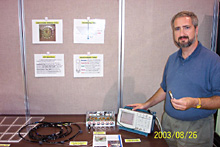Jim Priest Pitches In
This email came from Jim Priest, Fermilab's Fire Safety Engineer as he left to assist the Gulf Coast disaster recovery as part of an NFPA (National Fire Protection Association) team.
September 2
This might be the last email for a while and will try and will try
and text message if there is service. I am headed to
LA -Missip as part of a preliminary infrastructure and toxic chemical
evaluation team. Colleen is actually part of a team in
Louisville. My sister is going to stay with the girls as well as the baby
sister.
Should be back Weds will keep you informed.
Jim
Return to top

Lee Sawyer, DZero, Louisiana Tech.
(Click on image for larger version.) |
A Note from Lee Sawyer at Louisiana Tech
September 1, 2005
Thanks to the Fermilab community for wanting to help.
I have spoken to some of the local relief coordinators, and at the moment the best way to help is to give money to one of the following organizations: The American Red Cross, the Salvation Army, or Catholic Charities. Yahoo has setup a site for online donations to the Red Cross.
While there are foodbanks setup here, and a pressing need for clothing, toiletries, and shelter for the evacuees, the charitable organizations can handle the logistics of getting these items to people better than any of us can.
The situation in Louisiana is terrible, probably worse in fact than what you are hearing on the news. This is the worst disaster ever seen in the United States. We have thousands of people here in Ruston; they are being housed at our Civic Center, local churches, and motels. I will be helping with the 5:30 meal at our Methodist church, where about 200 families are staying. There are maybe 200 to 300 thousand evacuees throughout north Louisiana. While you have heard about the tragedy in New Orleans, there other places where the damage cannot even be estimated. Places downriver from New Orleans, like Buras or Venice, have not been heard from and may no longer exist. The north shore of Lake Ponchatrain was hit very hard, with maybe 100 thousand homeless in places like Covington, Bougalousa, Abita Springs, and Slidell. There are still many people left in New Orleans, and no way of contacting those who evacuated. I have a physics student from the Ninth Ward - one of the areas flooded by the breach in the levee - and I have no way of knowing if he has made it out. I have tried to contact the department heads at Tulane, UNO, and Xavier, and have so far only contacted one faculty member at UNO, who had evacuated to Arkansas.
Here at Louisiana Tech, we have postoned the start of classes, and we are enrolling students who have evacuated to north Louisiana. Students are also being enrolled in K-12 schools, since there is no prospect of them returning for weeks, perhaps months. Caruthers dormitory, shut down permanently several months ago, is being assessed and will be made available very soon for housing. Additionally, the concourse of the Thomas Assembly Center is being readied for about a hundred and fifty who can be temporarily housed there. The University is cooperating with government agencies by making available over 100 acres of land currently used for agricultural projects; this land may be used for mass housing provided by the government in the near future.
As many of you know, I am a native Louisianian. I am devasted by what has happened. Beautiful New Orleans, probably one of the most unique cities in the world, may never be the same again. I appreciate any help others may wish to send, and I ask that you keep the people of the Gulf Coast in your thoughts in the weeks to come. Vive la Louisiane.
Lee Sawyer
Physics Program Chair
Louisiana Tech University
Ruston, LA
Return to top
